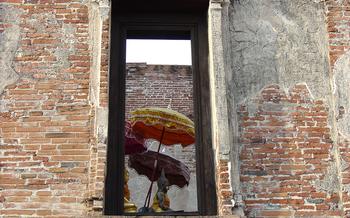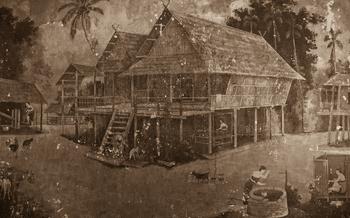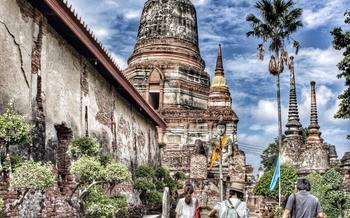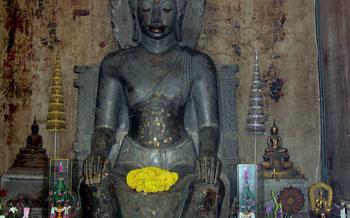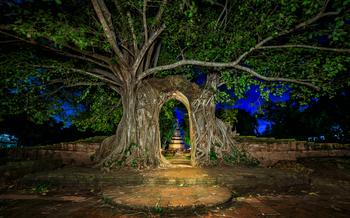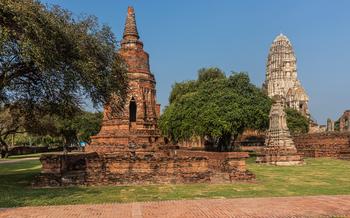
Wat Phra Phutthabat
- Wat Phra Phutthabat: A Sacred Buddhist Temple
- The Giant Footprint: A Symbol of Buddha's Enlightenment
- Exploring the Temple Grounds
- The Surrounding Landscape
- Scenic Vistas and Panoramic Views
- Nature Trails and Hiking Adventures
- Local Markets and Cultural Delights
- A Tapestry of Experiences
- Getting to Wat Phra Phutthabat
- Temple Etiquette and Dress Code
- Wat Phra Phutthabat for Meditation and Retreats
- Local Festivals and Events
- Wat Phra Phutthabat Museum
- Local Cuisine and Delicacies
- Sustainable Tourism Practices
- Accommodation Options
- Photography Tips
- Insider Tip
Wat Phra Phutthabat: A Sacred Buddhist Temple
Wat Phra Phutthabat, nestled in the heart of Lopburi, Thailand, is a revered Buddhist temple that holds immense historical, cultural, and religious significance. The temple's origins date back to the 13th century, where legend has it that a giant footprint of Buddha appeared on a rock, attracting devout pilgrims from far and wide. This sacred footprint, believed to be a symbol of Buddha's enlightenment, became the focal point of the temple's construction, making it a revered pilgrimage site for Buddhists worldwide.
Over the centuries, Wat Phra Phutthabat has undergone several renovations and expansions, resulting in a stunning architectural masterpiece that blends traditional Thai and Khmer styles. The temple complex features intricate carvings, colorful murals, and towering stupas that reflect the artistic and spiritual traditions of the era. It is a testament to the enduring legacy of Buddhism in Thailand and a symbol of the deep reverence for Lord Buddha's teachings.
The Giant Footprint: A Symbol of Buddha's Enlightenment
At the heart of Wat Phra Phutthabat lies a colossal footprint carved into a stone slab, measuring an awe-inspiring 16 meters in length and 8 meters in width. This monumental imprint is believed to be the sacred footprint of Lord Buddha himself, left behind during his earthly sojourn. According to legend, the footprint was created when Buddha, in a display of compassion, stepped onto the rock to subdue a giant naga (serpent) that was terrorizing the region.
The footprint holds immense spiritual significance for Buddhists, symbolizing Buddha's presence and teachings. It is believed that circumambulating the footprint clockwise while reciting mantras or prayers brings blessings, purifies karma, and accumulates merit. Devotees often prostrate themselves before the footprint, offering flowers, incense, and candles as a form of veneration.
Rituals and practices associated with the footprint include meditation, chanting, and mindfulness. Many visitors come to the temple seeking spiritual guidance and inner peace. They meditate in the vicinity of the footprint, focusing their attention on the teachings of Buddha and seeking enlightenment. The footprint serves as a powerful reminder of Buddha's presence and the path to liberation from suffering.
Exploring the Temple Grounds
Within the expansive grounds of Wat Phra Phutthabat, visitors will discover a treasure trove of notable structures and landmarks that reflect the temple's rich history and religious significance. One of the most striking features is the grand chedi, or stupa, which stands tall and majestic, adorned with intricate carvings and shimmering golden ornamentation. Devotees often pay homage at the chedi, offering prayers and making merit.
For those seeking spiritual reflection and meditation, the temple offers serene and tranquil spaces. Visitors can find secluded corners beneath ancient trees, where they can sit in silence and connect with their inner selves. The temple's peaceful atmosphere provides an ideal setting for contemplation and mindfulness.
The temple grounds also boast scenic spots that offer breathtaking views of the surrounding landscape. Visitors can climb to elevated points within the complex to capture panoramic vistas of the lush greenery and distant hills. These vantage points provide a unique perspective on the temple's grandeur and its harmonious coexistence with nature.
To cater to visitors' needs, Wat Phra Phutthabat features essential facilities such as restrooms and souvenir shops. The shops offer a variety of religious items, including Buddha statues, amulets, and prayer beads, allowing visitors to take home a piece of the temple's sacred essence. These amenities ensure a comfortable and enriching experience for all who visit.
The Surrounding Landscape
Nature's Embrace: Exploring the Enchanting Environs of Wat Phra Phutthabat
Beyond the sacred grounds of Wat Phra Phutthabat, nature unveils its captivating tapestry, inviting visitors to embark on a journey of exploration and discovery. Immerse yourself in the tranquility of the surrounding landscapes, where verdant hills, lush forests, and sparkling waterways create a harmonious symphony of beauty.
Scenic Vistas and Panoramic Views
As you wander through the temple complex, keep your eyes peeled for breathtaking vistas that unfold at every turn. From elevated vantage points, admire the panoramic views of the surrounding countryside, where rice paddies stretch out like a patchwork quilt, dotted with charming villages and shimmering rivers.
Nature Trails and Hiking Adventures
For those seeking a more active experience, the area around Wat Phra Phutthabat offers a network of nature trails that wind through dense forests and lead to hidden waterfalls, serene ponds, and ancient caves. Embark on a leisurely hike or a challenging trek, immersing yourself in the tranquility of the natural surroundings while discovering hidden gems along the way.
Local Markets and Cultural Delights
Venture beyond the temple grounds to explore the vibrant local markets and villages that dot the surrounding area. Immerse yourself in the authentic Thai way of life as you browse bustling marketplaces, sample delicious street food, and interact with friendly locals. Discover unique handicrafts, traditional textiles, and fresh produce that reflect the region's rich cultural heritage.
A Tapestry of Experiences
Whether you seek serene contemplation amidst nature's beauty, an adrenaline-pumping hike, or a taste of authentic Thai culture, the surroundings of Wat Phra Phutthabat offer a diverse tapestry of experiences. Embrace the opportunity to explore this enchanting region, where nature, history, and spirituality intertwine, creating an unforgettable journey for the senses.
Getting to Wat Phra Phutthabat
Visiting Wat Phra Phutthabat is a convenient and accessible experience for travelers. The temple is located just 20 kilometers from the city of Lopburi, making it an easy day trip from Bangkok or other nearby destinations.
To reach Wat Phra Phutthabat from Bangkok, several transportation options are available. Visitors can take a bus from the Northern Bus Terminal in Bangkok, which takes approximately 2 hours and 30 minutes. Alternatively, a more comfortable option is to hire a private car or taxi, which takes around 1 hour and 30 minutes.
For those coming from other parts of Thailand, there are direct buses from major cities such as Chiang Mai, Phuket, and Pattaya. These journeys can take longer, ranging from 6 to 8 hours, but they offer a scenic and affordable way to travel.
When planning a trip to Wat Phra Phutthabat, it's recommended to allocate at least half a day to fully explore the temple grounds and appreciate its beauty. Visitors can combine their visit with other attractions in Lopburi, such as the Lopburi Monkey Temple or the Prang Sam Yod, to create a comprehensive itinerary.
Temple Etiquette and Dress Code
Visiting Wat Phra Phutthabat requires visitors to be mindful of proper attire and behavior. As a sacred Buddhist temple, it is essential to show respect for the religious significance of the site. Visitors should dress modestly, covering their shoulders and knees. Revealing or tight-fitting clothing is not appropriate. When entering the temple grounds, it is customary to remove shoes and leave them in the designated area.
Within the temple, visitors should maintain a respectful demeanor. Loud talking, laughing, or boisterous behavior is discouraged. It is important to be mindful of the ongoing religious ceremonies and rituals and avoid disrupting them. When visiting the giant footprint, it is considered disrespectful to step on it or touch it with one's feet. Instead, visitors should pay their respects by bowing or kneeling in front of the footprint.
Photography is generally allowed within the temple grounds, but it is essential to be respectful when taking photos. Avoid using flash photography, especially during religious ceremonies. It is also important to ask permission before photographing monks or other individuals. By following these guidelines, visitors can ensure a positive and respectful experience at Wat Phra Phutthabat.
Wat Phra Phutthabat for Meditation and Retreats
Wat Phra Phutthabat offers a serene and conducive environment for meditation and spiritual retreats. The temple's tranquil atmosphere, surrounded by nature's beauty, provides an ideal backdrop for self-reflection and spiritual growth. Visitors seeking a deeper connection to their inner selves can participate in meditation retreats organized by the temple's resident monks and practitioners. These retreats typically involve guided meditation sessions, teachings on Buddhist philosophy, and mindfulness practices.
The temple provides simple accommodations for retreat participants, ensuring a comfortable and distraction-free stay. Retreats at Wat Phra Phutthabat offer a unique opportunity to immerse oneself in Buddhist traditions and learn from experienced practitioners. Participants can benefit from the teachings and guidance of the monks, who share their wisdom and insights on meditation and spiritual development.
Attending a meditation retreat at Wat Phra Phutthabat can be a transformative experience, allowing individuals to deepen their understanding of Buddhism, cultivate inner peace, and gain valuable tools for personal growth. The serene atmosphere of the temple, combined with the teachings and support of the monks, creates a conducive environment for spiritual exploration and self-discovery.
Local Festivals and Events
Wat Phra Phutthabat comes alive during its annual festivals and events, which showcase the vibrant local culture and traditions. The most notable festival is the Phra Phutthabat Fair, held annually in February or March. This grand celebration features colorful parades, traditional music and dance performances, and a lively market filled with local delicacies, handicrafts, and souvenirs. Devotees from across the country gather to pay homage to the sacred footprint and participate in merit-making activities.
Other significant events include Visakha Bucha in May, which commemorates the birth, enlightenment, and passing of Lord Buddha, and Asalha Bucha in July, which marks the beginning of Buddhist Lent. During these festivals, the temple is adorned with intricate decorations, and special ceremonies and rituals are held to honor Buddha's teachings. Visitors can immerse themselves in the festive atmosphere, learn about Thai Buddhist traditions, and experience the deep devotion of the local community.
Wat Phra Phutthabat Museum
The Wat Phra Phutthabat Museum is a treasure trove of artifacts and exhibits that shed light on the rich history and significance of Wat Phra Phutthabat. Visitors can embark on a journey through time as they explore the museum's collection, which includes ancient Buddha images, religious texts, and historical documents.
One of the highlights of the museum is the collection of Buddha footprints, which are believed to be replicas of the actual footprint enshrined within the temple. These footprints, crafted from various materials such as bronze and stone, provide a glimpse into the devotion and craftsmanship of past artisans.
The museum also houses a collection of ancient inscriptions and stelae that provide valuable insights into the temple's history and the surrounding region. These inscriptions, written in various languages and scripts, offer a glimpse into the cultural and religious exchanges that took place in Lopburi throughout the centuries.
Guided tours of the museum are available, providing visitors with an in-depth understanding of the exhibits and their significance. These tours are led by knowledgeable guides who share fascinating stories and anecdotes about the temple's history and traditions.
The Wat Phra Phutthabat Museum plays a crucial role in preserving the temple's heritage and educating visitors about its religious and cultural importance. By exploring the museum's collection, visitors gain a deeper appreciation for the temple's enduring legacy and its profound impact on the history of Thailand.
Local Cuisine and Delicacies
Wat Phra Phutthabat is situated in the heart of Lopburi, a province renowned for its rich culinary heritage. Visitors can indulge in a variety of local dishes and delicacies that showcase the unique flavors of Thai cuisine.
One must-try dish is Khao Piek, a flavorful rice noodle soup with a rich coconut milk broth. The soup is typically topped with chicken, beef, or seafood, along with vegetables and herbs. Another local specialty is Sai Krok Isan, a grilled fermented sausage made from pork or beef. The sausage has a distinctively sour and spicy flavor and is often served with sticky rice and fresh vegetables.
For a refreshing treat, visitors can try Nam Tok, a spicy waterfall beef salad made with grilled beef, onions, chilies, mint, and lime juice. Those who prefer vegetarian options can opt for Som Tum, a papaya salad made with green papaya, tomatoes, carrots, peanuts, and a spicy dressing.
To experience the authentic flavors of Lopburi cuisine, visitors can head to the local markets, where they can find fresh produce, herbs, and spices. Cooking classes and workshops are also available for those who wish to learn more about Thai culinary traditions and recreate these delicious dishes at home.
Sustainable Tourism Practices
Wat Phra Phutthabat, like many sacred sites around the world, faces the challenge of balancing tourism with the preservation of its natural and cultural heritage. As responsible travelers, we have a role to play in ensuring that our visit to this sacred temple is sustainable and respectful.
Here are some tips for practicing sustainable tourism at Wat Phra Phutthabat:
- Reduce waste: Avoid single-use plastics and opt for reusable water bottles and shopping bags.
- Respect local customs: Dress appropriately, behave respectfully, and follow the temple's guidelines for visitors.
- Support local businesses: Choose locally-owned restaurants and shops that support the local economy and promote cultural preservation.
- Conserve water and energy: Be mindful of your water and electricity usage, especially during times of drought or energy shortages.
- Protect the environment: Avoid littering and damaging plants or wildlife.
- Educate yourself: Learn about the temple's history, significance, and local customs to appreciate it more deeply.
By following these principles, we can help ensure that Wat Phra Phutthabat remains a place of peace, tranquility, and cultural significance for generations to come.
Accommodation Options
Wat Phra Phutthabat offers a variety of accommodation options for visitors, catering to different budgets and preferences.
-
Hotels: For those seeking comfort and convenience, there are several hotels in the vicinity of the temple. These hotels offer a range of amenities, including air-conditioned rooms, private bathrooms, and on-site restaurants.
-
Guesthouses: For a more affordable option, guesthouses provide basic but comfortable accommodations. These guesthouses often have shared bathrooms and common areas, fostering a sense of community among travelers.
-
Homestays: To experience local culture and hospitality firsthand, consider staying at a homestay. Homestays offer a unique opportunity to interact with local families and gain insights into their daily lives.
When choosing accommodation, it's essential to consider factors such as location, budget, and desired amenities.
-
Location: If you plan to explore the surrounding areas, choose a hotel or guesthouse within walking distance of the temple. If you prefer a more secluded experience, consider a homestay in a nearby village.
-
Budget: Accommodation prices vary depending on the type of establishment, location, and amenities offered. Budget travelers can find guesthouses and homestays for as low as 200 baht per night, while hotels typically start at around 500 baht per night.
-
Amenities: Consider the amenities that are important to you, such as air conditioning, private bathrooms, and Wi-Fi. Some accommodations may also offer additional services like laundry, bike rentals, and tour arrangements.
Tips for finding the best deals:
-
Book in advance: Especially during peak season, it's advisable to book your accommodation well in advance to secure the best rates and availability.
-
Consider midweek stays: Weekends and holidays tend to be busier and more expensive, so consider staying during the week for more affordable options.
-
Look for discounts: Many hotels and guesthouses offer discounts for long-term stays or group bookings.
-
Ask for recommendations: Local tour operators or travel agents may have partnerships with accommodations and can provide valuable recommendations based on your preferences and budget.
Photography Tips
Capturing the Essence of Wat Phra Phutthabat Through Your Lens
Wat Phra Phutthabat offers a treasure trove of photographic opportunities, allowing visitors to capture the temple's grandeur and spiritual essence through their lenses. To make the most of your photography experience, consider these tips:
-
Embrace the Golden Hour: The warm, diffused light of sunrise and sunset casts a magical glow on the temple, creating stunning photo opportunities. Arrive early or stay late to witness the temple bathed in this ethereal light.
-
Explore Different Perspectives: Experiment with various angles and vantage points to capture unique compositions. Climb the surrounding hills for panoramic views, or get close to capture intricate details of the temple's architecture and sculptures.
-
Play with Light and Shadow: The interplay of light and shadow adds depth and drama to your photographs. Observe how the sunlight illuminates different parts of the temple throughout the day, creating striking contrasts and silhouettes.
-
Capture the Spiritual Atmosphere: Wat Phra Phutthabat exudes a palpable spiritual energy. Look for moments of devotion, such as monks chanting or pilgrims paying homage to the giant footprint. These candid shots will convey the temple's sacred atmosphere.
-
Respect Local Customs: Always ask permission before photographing people, especially monks. Be mindful of local customs and traditions to ensure you don't cause any offense or disruption during your photography session.
Insider Tip
Unveiling the Hidden Gems of Wat Phra Phutthabat
Beyond the main attractions of Wat Phra Phutthabat, there are hidden gems waiting to be discovered by curious travelers. One such secret spot is the ancient meditation cave, located within the temple grounds. This secluded cave offers a tranquil retreat for those seeking spiritual reflection and inner peace. Visitors can immerse themselves in the serene atmosphere, surrounded by flickering candlelight and the gentle sound of dripping water.
Another highlight for those interested in local traditions is the annual merit-making ceremony held at the temple. This vibrant festival attracts devotees from near and far who come to pay homage to the Buddha and make offerings to the monks. Visitors can witness the colorful processions, partake in traditional rituals, and receive blessings from the temple's revered abbots.
To experience the temple's rich history, I recommend visiting the Wat Phra Phutthabat Museum. This small but informative museum houses a collection of artifacts, ancient inscriptions, and historical documents that shed light on the temple's origins and significance. Visitors can gain a deeper understanding of the temple's role in Thai culture and its enduring legacy as a sacred Buddhist site.
My personal anecdote from visiting Wat Phra Phutthabat is a memorable encounter with a local monk who shared fascinating stories about the temple's legends and traditions. His insights and teachings left a profound impact on me, deepening my appreciation for the temple's spiritual significance and the kindness of the local community.
By venturing beyond the main tourist areas and embracing the local customs, travelers can uncover the hidden treasures of Wat Phra Phutthabat and create lasting memories of their time in this sacred and enchanting place.

